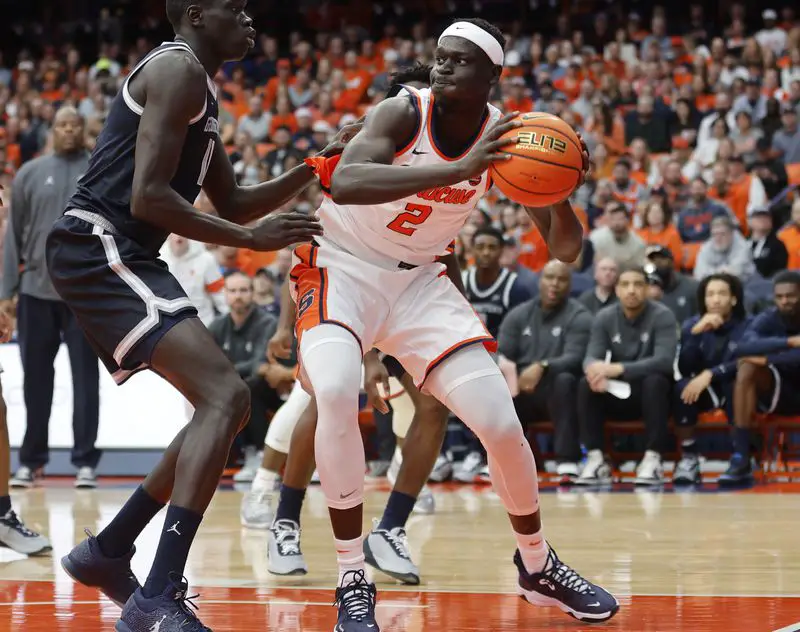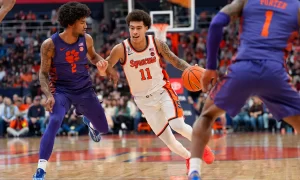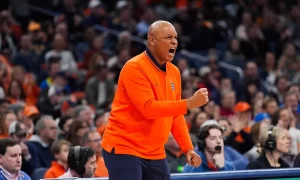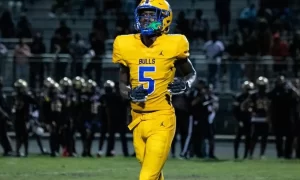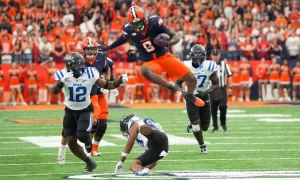Syracuse men’s hoops just pulled off what last year’s Orange squad could not – hold on to a double-digit halftime lead against Georgetown. This year, SU led the Hoyas by 11 at the break and never let things get truly close. ‘Cuse played efficient offense and mostly stayed within the paint, while its defense shut down a one-dimensional Georgetown attack. Syracuse’s bigs carried plenty of the defensive freight. Senior Jesse Edwards finished with 20 points and 11 boards, backup Mounir Hima blocked three shots, and an unlikely third source played admirably yet again: redshirt-junior John Bol Ajak.
In front of fellow countryman and 2003 SU team captain Kueth Duany, Ajak again turned in a solid effort off the bench. The 6’10” big played 20 minutes to lead all Syracuse bench players, grabbed five rebounds, and tallied a pair of both assists and steals. The effort wasn’t perfect by any means – four fouls, a bad rifled pass straight to the Hoyas’ Wayne Bristol Jr., and a lost shoe were par for the course – but it might be time to stop peeking through your fingers every time “Bol” enters a game. The numbers and eye test back up what he’s doing to solidify the SU defense.
“He’s playing good defense, he’s active, he’s getting back and rebounding. He’s facilitating things on offense. He’s just playing really solid basketball.” (Jim Boeheim on John Bol Ajak, 12/10/22)
In seasons past, Ajak was (fairly or not) regarded as one of the weaker links on SU’s bench. Even on a team with problems at the five and limited depth, Ajak wasn’t considered a viable option. He redshirted in 2019-20, played only 51 minutes the next year, and only 62 the next. Entering this season, Ajak had eight more career fouls (15) than points (7). All he’s done this year is steady to become a suddenly versatile option off Jim Boeheim’s bench.
On the Fizz, we wrote a little about why Bol was suddenly playing more following his career-high 27 minutes against Bryant and an 18-minute effort against Notre Dame on December 3. The answer is fairly simple: he’s both a solid passer and plays Boeheim’s 2-3 zone as intended. Since he can do that, any rust-related mistakes he makes can be mostly tolerated.
It’s no secret that SU has struggled mightily to defend the perimeter this season. Colgate’s air raid of 19 triples back in November only kicked off what’s been a bad Orange trend. Even after facing an inept three-point shooting Georgetown team, SU still ranks 348th out of 363 Division I teams in opponent three-pointers made per game. A big reason for such difficulty is bad positioning. SU’s forwards (namely Chris Bell and Benny Williams) have had a bad habit of straying too high in the zone and leaving corner shots open. Guards simply pitch and catch to open wings in the corners, who regularly drain shots on SU’s defense if Jesse Edwards or someone else can’t scramble over in time.
With Ajak in the fold, that happened much less against the Hoyas. There’s a reason Boeheim left lineups with two bigs on the floor in Mounir Hima and Ajak at times – not just to provide more size against a big Georgetown team, but because Ajak was shoring up that positioning weakness. The South Sudan native finished +8 in 20 minutes against the Hoyas, who only hit six of 25 three-pointers. SU turned in another strong defensive performance and is up to 173rd in scoring defense. That ranking isn’t very impressive, but it’s far better than last year’s squad that placed 314th nationally in the same category.
As SU ventures into a few more winnable games ahead of a January ramp-up in competition, keep your eye out for the minutes Ajak commands at power forward versus Benny Williams and freshman Maliq Brown. Jesse Edwards is still the most important defensive player on Syracuse’s roster, but whoever commands size and presence beside him in the zone is a position battle to watch in the coming weeks.
Ultimately, a strong start against non-conference competition doesn’t anoint John Bol as a new weapon off the bench, but it’s encouraging to see him progress. A lot has been made about how shaky Edwards looked during his first year and a half in Orange versus what he’s become as a starter. Ajak may not be the same caliber player, but a similar arc from understudy to surprise contributor wouldn’t be all that shocking. For Syracuse’s sake, the early returns from a surprising source are nothing but encouraging.


